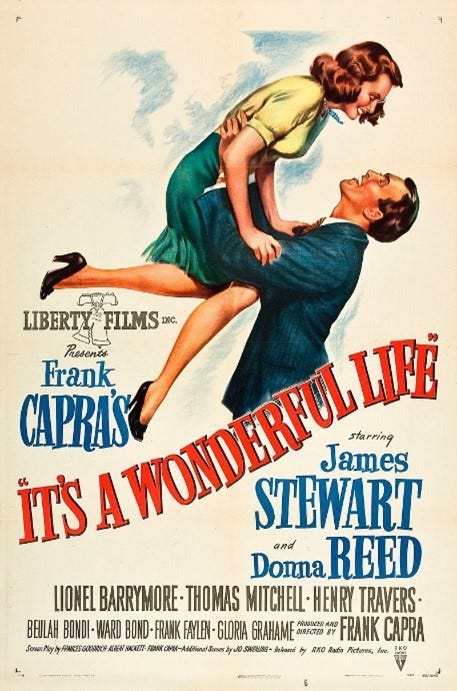“I always felt the world cannot fall apart as long as free men see the rainbow, feel the rain and hear the laugh of a child.” -Frank Capra
Source: Wikimedia Commons
If you didn’t know it, the Haymaker graduated with a degree in cinema studies and filmmaking back when woolly mammoths were still roaming the planet. That’s not something the author of a financial newsletter readily admits to (for fear of setting off a wave of cancellations)! Perhaps I’m willing to do so because it’s tough to turn down a free investment newsletter. Or maybe it simply relates to being old enough to have had Frank Capra as a mentor and, consequently, I don’t worry about alienating the squeamish among our readers. Besides, alienation is one of the things I do best, at least for those who have an aversion to the facts–such as last year being the culmination of the biggest bubble in recorded human history.
You may not recall Mr. Capra by name, but I’ll bet you’ve watched one of his films, probably many times. There may be no more popular Christmas film than It’s A Wonderful Life (1946) starring Jimmy Stewart and Donna Reed. As ironic as it was iconic, the film was a box-office bust. In fact, it sent Mr. Capra’s career into a tailspin from which it never recovered. The man who owned Hollywood in the 1930s and early 1940s was essentially a has-been by 1950.
Source: Wikimedia Commons
His fall from grace coincided with the post-war rise of a genre which he detested: film noir. In his autobiography, The Name Above the Title, Mr. Capra railed against the antiheroes who were the focus of these dark films (“noir” in French literally means “black”). These gritty, often repulsive, characters were in stark contrast to the humble and selfless protagonists of Mr. Capra’s films like Jefferson Smith (also played by Jimmy Stewart) in Mr. Smith Goes to Washington.
Among the signature film noirs of that era was 1947’s Nightmare Alley, featuring Tyrone Power and Joan Blondell. To most readers, though, it was last year’s remake starring Bradley Cooper and Cate Blanchett that was their introduction to this turgid tale of a conman, a psychic, and a psychiatrist.
Lately, the stock market has taken on the look and feel of a film noir script. In its peculiar way, it is acting out its own con game by sucking in folks as sophisticated as Jim Cramer, who last month proclaimed that the bear market was over. The recovery that happened from mid-March to March 29th was truly dazzling, as bear market rallies so often are. The S&P popped 10 ½% while the NASDAQ 100, heavily populated with the last decade’s biggest winners, soared nearly 18%. In fact, this rally was so vigorous it ranked in the 98th percentile of bear market rallies, taking into account the speed of the move. No doubt, this is what caused Jim Cramer, who is highly momentum driven, to issue his declaration right around the peak of that recovery.
Frankly, only the swoons in the NASDAQ and the Russell 2000 (small cap) Index qualify as actual bear events, at least among the popular averages. It did briefly hit the down 20% mark, popularly considered the bear market threshold, on March 14th. Yet, I think it’s reasonable to assert it’s the “NAZ” that has been the object of most investors’ affection over the last five years or more. The S&P 500 itself never came close to being in a true bear market. Thus, I believe Jim “Booyah” Cramer tacitly admitted the NASDAQ has become the market these days when he made his typically rash and emphatic declaration that the bear was dead.
For years, the way to goose market returns was to follow the mantra “Buy the Dip”. Typically, this had a colorful word between “the” and “dip”. It was almost like having a printing press worthy of the Fed. Of course, it was the latter’s actual Magical Money Machine that prevented anything more than fleeting downturns since 2009. Accordingly, like Pavlov’s dogs, investors became conditioned to view any setback as a buying opportunity, one they would jump on at the ringing of their favorite bell: the opening gong of the New York Stock Exchange.
Source: Digital Mom Blog (And they’ve shared plenty more)
It's reasonable to argue that gambit paid off once again in mid-March, per the rambunctious rally described above; ergo, “buy the dip” lives. Or does it? On the contrary, I would argue, as I did earlier this year, that it’s now “Sell The Rips”, particularly when it comes to still heroically valued growth stocks. Without question, the number of those is shrinking like the Fed’s credibility these days, and that’s actually a relevant analogy. Moreover, it only took a few weeks to push stocks back down to their mid-March lows. Accordingly, all those who listened to Jim Cramer and fell for the Nightmare Rally have fresh losses to show for having forgotten the lessons of past bear markets.
Also unquestionably, the Fed is on a mission to restore its inflation-fighting credentials which it so thoroughly trashed during last year’s embarrassing “It’s only transitory” debacle. The metamorphosis from a gaggle of doves on the Federal Open Market Committee (FOMC) to a flock of hawks has been truly remarkable. Moreover, the members couldn’t be more transparent about their plan of action. However, most investors seem to be of the opinion that the investing mise-en-scene, to use another French cinematic term, is the same-old, same-old. Naturally, I beg to differ, as I am so often given to do.
As I wrote in A Belated Epiphany, I believe former NY Fed President Bill Dudley totally let the cat out of the bag recently and it’s more cougar than calico. His contention is that the Fed needs to create deflation in financial assets in order to control that other “flation”. When it comes to bonds, it’s mission accomplished. The first quarter was the worst for fixed-income since 1980. But, as noted, with stocks it’s only the higher risk indexes that have entered bear market territory… for now.
Historically, stocks often continue to rise in the early stages of a Fed tightening cycle. What’s different this time, however, is that it’s turning the screws when the odds of a global recession are on the rise. Even the U.S. stock market is reflecting that with stable demand stocks generally making new all-time highs. Utility shares are a graphic illustration of that, as are REITs (though the latter’s recession-resistant track record isn’t great).
Fears of a worldwide economic contraction have become so intense lately that the beneficiaries of our current Age of Shortages where the only thing that isn’t in short supply is things in short supply — have also come down hard. As I highlighted in last Monday’s Making Hay post, this includes America’s premier copper producer, Freeport-McMoran, which had retreated a quick 20% before bouncing this week. Gold miners have also been slapped around, diminishing what had been a stellar start to the year. However, they remain up about 14% in 2022, a notable accomplishment in a year in which the S&P has now retreated 12%.
Due to the sudden correction in precious metals, many are once again dissing gold and the companies that extract it, an increasingly difficult endeavor. Frankly, like so many commodities, the yellow metal is supply challenged. Gold inventories have recently dropped below their five-year average. Per Barron’s, quoting Wells Fargo’s head of real asset strategy, John LaForge, every time that’s occurred since 1900 it has triggered a multi-year rally.
This harks back to one of my main investment recommendations in recent years: Invest in what’s scarce. Clearly, government bonds that can be created willy-nilly – and fiat currencies, like the dollar, which have been printed by the tens of trillions in recent years – don’t qualify. Certainly, all those cryptos that can be fabricated without limitation don’t make the scarcity grade, nor do a plethora of NFTs (Non-Fungible Tokens). Even with stocks, which were being issued in droves during last year’s IPO (new issue) boom, one needs to be highly selective and avoid the multitude of overpriced names. This is despite the huge swoons so many of them have endured since last fall.
On the other hand, the critical inputs for producing electric vehicles (EVs) are scarce and becoming more so. Lithium’s 1000% moonshot since 2019 is reflective of that, as are the hockey stick moves in metals such as cobalt and nickel. Copper is “only” up 80% from its pre-pandemic level but it may be poised to have another upside blow-off. (In an interview with Jim Cramer on Wednesday, Ford CEO Jim Farley was bemoaning the surging costs and lack of availability of these materials, as well as semiconductors.)
Energy is another obvious example of a supply-challenged sector. While natural gas prices in the U.S. are a fraction of what they are in Europe and Asia, it has roughly tripled here over the last two years. Inventories are extremely tight. As the U.S. further ramps up already rapidly growing LNG exports to Europe, domestic gas in storage may get drawn down to a greater, potentially dangerous, degree. Russia’s suspension on Wednesday of natural gas shipments to Poland and Bulgaria emphatically underscores the criticality of US LNG.
With oil, it’s much the same story. U.S. oil stocks are at 20-year lows and the impact of the loss of Russian crude supplies has only recently begun to be felt. It’s clear OPEC is having difficulties raising its production up to its allowed quota levels. Our best source of intel on the oil market is convinced it will be out of spare capacity by the end of this year.
Yet, as noted above, most of these natural resource-related stocks have been swooning lately, due to a combination of spreading Chinese lockdowns and escalating global recession fears. The same situation occurred right after Thanksgiving when Omicron began to go viral — literally – giving investors an opportunity to buy into these real asset sectors at marked-down prices.
The big difference is that unlike last November, the Fed is now playing chicken with the markets. It is determined to tighten liquidity by both drastically raising rates and shrinking its nearly $9 trillion hoard of treasury bonds and government-backed mortgages. As I’ve written before, this is known as a double-tightening and it’s only the second time it’s been done; the first was in 2017 and 2018, eventually it led to the S&P tumbling 20%. Thus, this is not a time to be going all-in on stocks, even with the most attractive issues and sectors.
Per Bill Dudley, the Fed now seems to want stocks to fall to cool inflation. It was the latter that our beloved central bank wanted much more of as recently as the summer of 2020. As I predicted at the time, it got what it wanted — good and hard. Now, I think it’s going to get the bear market it wants and, again, in this case, much more value destruction than it is anticipating.
However, it’s unlikely to be an uninterrupted glissade down the mountainside. Bear market rallies are notorious for being explosive and dazzling. In the 2000 to 2002 slow-motion meltdown, the NASDAQ surged from 10% to 50% on 15 different occasions, per former Barron’s Roundtable member Fred Hickey. Nevertheless, the NASDAQ tanked by almost 80% during those years while the S&P 500 was cut in half. Remarkably, that carnage occurred with the Fed easing the majority of the time.
In March’s big snap-back, the hardest-hit parts of the market shot up the most. Cathie Woods’ once high-flying ARKK Innovation ETF leapt 29% in two weeks while the archetypical meme stocks, GameStop and AMC Entertainment rocketed an astounding 143% and 116%, respectively.
Enormous volume accompanied the latter two moves, indicating a lot of suckers investors couldn’t resist the siren song of a possible repeat of their spectacular ascents in the first half of 2021. This is where the nightmare-rally part truly leads to a grisly ending. GameStop has given back a quick 30% and AMC has essentially been cut in half, leaving it right back where it was prior to its nonsensical moonshot (based on buying into a bankrupt gold miner!). As for ARKK, it has surrendered that entire 29% rebound and just made another new low for the year. This leaves it down a stunning 67% from 2021’s peak when it was attracting tens of billions of performance-chasing investor dollars.
What’s concerning is that the bloodletting is spreading beyond the lottery-ticket-type stocks. Even the storied FAANGM stocks — Facebook, Apple, Amazon, Netflix, Google, and Microsoft — are showing signs of breakage. Actually, Netflix hasn’t just broken, it’s been utterly shattered, cliff-diving from $685 less than six months ago to $189 on Wednesday. To save you reaching for a calculator, that’s a 73% haircut — make that a buzz-cut… with a chainsaw.
Another major concern I have is the torrent of retail money that flowed into stocks last year during what I, and others, have called the “peak insanity” phase (when GameStop hit nearly $500 a share, up from $5 mere months earlier). Inflows into equity mutual funds in 2021 were higher than the prior 25 years combined and are on pace for almost the same total this year. As the legendary Bob Farrell has often pointed out, the public buys the most at tops and the least at troughs.
Similarly, corporations have also been frantically buying back their own shares over this timeframe. Their track record is just as dismal as retail investors.
With all the aforementioned negatives piling it up, it could truly be a nightmarish summer, particularly for those who sell in a panic and then get conned by the intoxicating rallies. If the 2000-2002 bear market is any guide, there might be even more of those up ahead. Yet, they may materialize from successively lower lows.
It’s my belief that, ultimately, the financial market distress will become so acute it will necessitate the Fed using one of its own tactical nukes. In 2016, then-Fed Chairman Janet Yellen told us what those were: the Fed buying corporate bonds and, if necessary, stocks. Fulfilling one of my most controversial anticipations, the Fed executed the bond part in March 2020. This turned the Covid crash into a raging bull market literally overnight.
Should the S&P tumble as much as 30%, the Fed is likely to announce a “portfolio rebalancing”, as I’ve opined in the past. It has $1 trillion in T-bills coming due over the next year. Consequently, it can just let those mature at an average of $250 billion a quarter and redeploy some of that into stocks. As with its corporate bond intervention in 2020, the odds are very high it won’t need to buy all that many shares to produce a dramatic rally as private participants get the message that the Fed Put isn’t kaput, after all. In my view, it just has a lower price at which it will be activated.
In the meantime, be careful. That Fed Put point, or strike price, is way below where the S&P is currently trading. And, of course, be particularly wary of any ensuing nightmare rallies. Don’t let them con you into thinking the bear market is over. Instead, be prepared for an ending that’s much more film noir and a lot less Frank Capra.
An Ask Of Our Subscribers
Haymaker has a lot of rounds ahead in what would be a very tough fight without you in our corner. You can back us up by tapping the heart and, even better (though we appreciate both), weighing in with a comment. If you haven’t done so, look for the intuitive shapes, and keep your favorite financial pugilist punching with all his might.
Okay, that’s the bell. We’re back at it.







Your missive has become a must read. Thanks for keeping it real.
Wow, very compelling! Question is; How do we go from this "Nightmare Rally" to "It's a Wonderful Market"? Looks like it will be some time before that film is made...
Thanks David!